Parabolic collectors
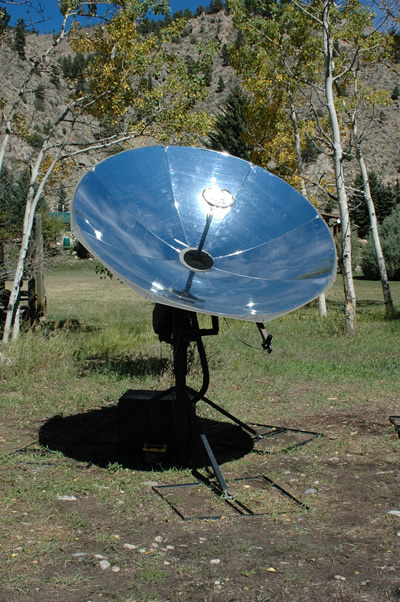
|
This parabolic solar concentrator dish collects about 3 square meters of sunlight. At 100% efficiency it should produce about 3000 watts of power or 10242 BTU per hour. In actuality it produces about 1873 watts or 6391 BTU per hour. This is a system efficiency of about 62%.
Experiment date 9/25/07
Ambient temp 65˚F 83 pounds of water (This is about 10 gallons at 8.33 pounds per gallon.) 1 BTU raises 1 pound of water 1˚F 77˚F change of 83 pounds of water = 6391 BTU BTU / hour to Watts = BTU / hour x 0.293 Watt-hours to BTU = Watts x 3.414 1873 actual watts / 3000 potential watts = 62.4% efficiency 1873 watts of solar thermonuclear radiation was being collected at the focal point by the collector coil.
|
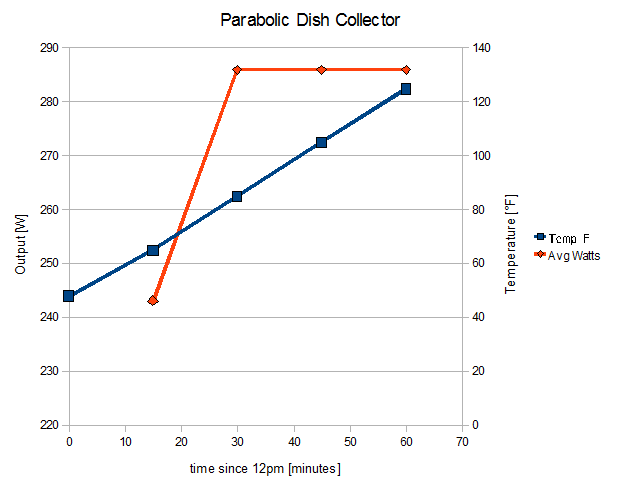
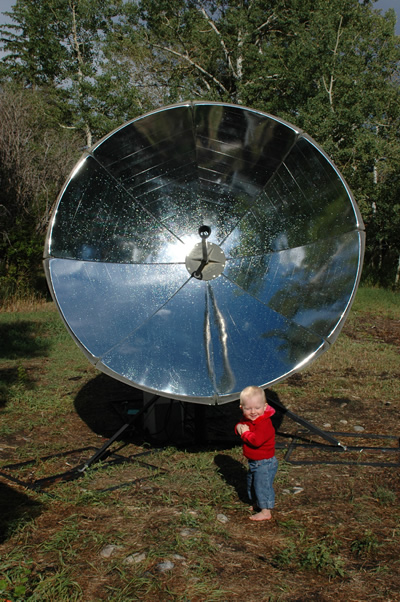 |
This solar concentrator is an eight segment solid aluminum parabolic dish. The surface of the dish was washed and then adhesive mylar was applied in 3" wide strips. We started from the outside of each segment and worked toward the center. This method seemed to produce the least amount of material overlap.
We tried applying the mylar several different ways but found that 3" wide strips were easiest to manage. It was faster and less tedious to keep air bubbles from getting trapped under the reflective when applying strips as opposed to larger pie shaped sections. Larger pie sections also tended to wrinkle a few hours after application, this was not so with the strips. The weatherability of this mylar material is unknown. At the time of this photograph the mylar had been on the dish for about a month. The Heliotrack mascot is pictured here for scale. |
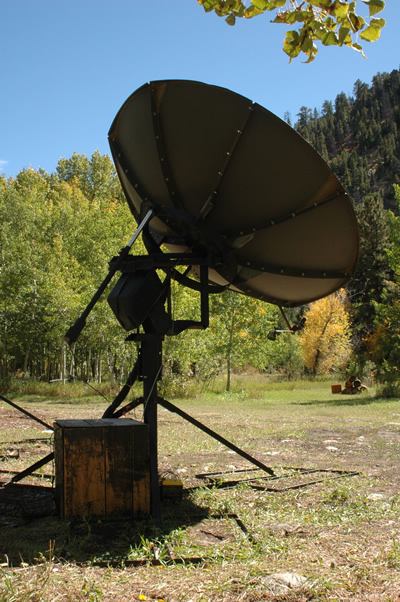 |
The original stand for this dish was single axis with an 18" linear actuator.
A new two axis mounting frame was constructed from recycled angle iron. The first axis from ground is a horizon to horizon rotary actuator that provides 170˚ of azimuth motion. The second axis from ground is the original 18" linear actuator that now provides 90˚ of altitude adjustment. The linear actuator does very little work since the azimuth actuator can be aligned with the polar axis of the Earth, it primarily provides seasonal adjustment and makes only slight adjustments a few times per day. In this picture you can see the insulated box containing the storage tank and circulation pump. |
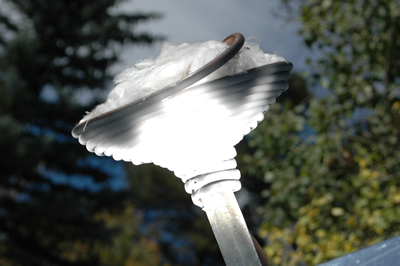 |
The CSP collector element is a 10" diameter spiral coil of 3/8" soft copper tube. To absorb more energy it has painted with high temperature black B-B-Q paint purchased from Home Depot. Water, antifreeze, or mineral oil is circulated through the collector coil and then through another copper heat exchange coil in the holding tank or boiler.
The white fiberglass insulation on the back of the coil is there to reduced re-radiation and convection losses. |
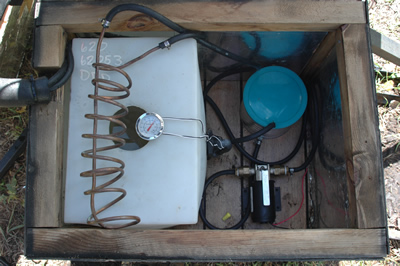 |
The tank heating element is a coil of 1/4"copper tube. The temperature difference between the inlet and outlet of the cooling coil is 40˚F at a circulation volume of .3 gallons per minute.
It is imperative that this system has some means of pressure relief. At some point the transfer fluid will flash into steam causing pressure buildup in the system. It is possible to get a constant flow of steam by using a positive displacement feed pump adjusted to the proper flow rate. |
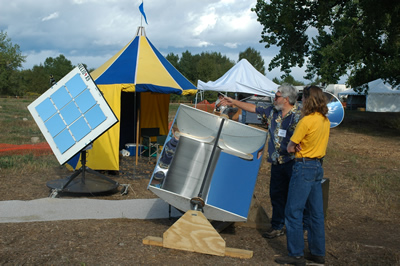 |
Here is a parabolic trough collector that we use for water heating or water distilling, basically a thermal collector. On a full day of sun we can distill about one gallon of water. The reflector material is plexi-mirror wrapped around two parabolic plywood ends. It uses a single axis solar tracker. The collector pipe is painted black to absorb the heat from the sun, it also acts as the axis of rotation for the trough. |
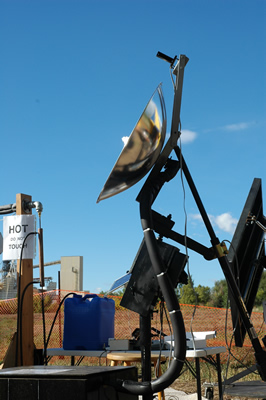 |
This is a prototype parabolic dish thermal collector. In this case we are using it to heat water. Parabolic dish collectors require dual-axis solar tracking. The collector element is a coil of 1/4"copper tube painted with high temperature black paint. The tracking range of this dish is 300˚ which makes it great for higher latitudes, it also has a tilt back feature for low latitude operation where the sun seasonally goes from the northern to southern sky. |
 |
The collector element is a coil of 1/4"copper tube painted with high temperature flat black paint. Water or antifreeze is circulated through the collector coil and then through a copper heating coil in a holding tank. We can heat about 10 gallons of water from 60˚F to about 120˚F in 8 hours. This dish collects about .28 square meters of sun. If it were 100% efficient it would produce about 280 watts of power or 956 BTU's per hour or 7648 BTU in 8 hours. In actuality it produces about 4980 BTU in 8 hours. This is a system efficiency of about 65%. (Constants needed to do the math) |
